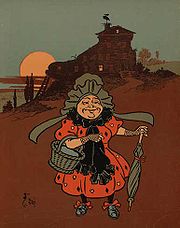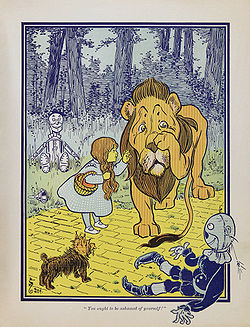
William Wallace Denslow
Encyclopedia


L. Frank Baum
Lyman Frank Baum was an American author of children's books, best known for writing The Wonderful Wizard of Oz...
, especially his illustrations of The Wonderful Wizard of Oz
The Wonderful Wizard of Oz
The Wonderful Wizard of Oz is a children's novel written by L. Frank Baum and illustrated by W. W. Denslow. Originally published by the George M. Hill Company in Chicago on May 17, 1900, it has since been reprinted numerous times, most often under the name The Wizard of Oz, which is the name of...
. Denslow was an editorial cartoonist with a strong interest in politics, which has fueled political interpretations of The Wonderful Wizard of Oz
Political interpretations of The Wonderful Wizard of Oz
Political interpretations of The Wonderful Wizard of Oz include treatments of the modern fairy tale as an allegory or metaphor for the political, economic and social events of America in the 1890s...
.
Biography
Born in Philadelphia, Denslow spent brief periods at the National Academy of DesignNational Academy of Design
The National Academy Museum and School of Fine Arts, founded in New York City as the National Academy of Design – known simply as the "National Academy" – is an honorary association of American artists founded in 1825 by Samuel F. B. Morse, Asher B. Durand, Thomas Cole, Martin E...
and the Cooper Union
Cooper Union
The Cooper Union for the Advancement of Science and Art, commonly referred to simply as Cooper Union, is a privately funded college in the East Village neighborhood of Manhattan, New York City, United States, located at Cooper Square and Astor Place...
in New York, but was largely self-educated and self-trained. In the 1880s, he traveled about the United States as an artist and newspaper reporter; he came to Chicago for the World's Columbian Exposition
World's Columbian Exposition
The World's Columbian Exposition was a World's Fair held in Chicago in 1893 to celebrate the 400th anniversary of Christopher Columbus's arrival in the New World in 1492. Chicago bested New York City; Washington, D.C.; and St...
in 1893, and chose to stay. Denslow acquired his earliest reputation as a poster artist; he also designed books and bookplates, and was the first artist invited to work at the Roycroft Press.
Denslow may have met Baum at the Chicago Press Club, where both men were members. Besides The Wonderful Wizard of Oz, Denslow also illustrated Baum's books By the Candelabra's Glare
By the Candelabra's Glare
By the Candelabra's Glare is a 1898 collection of poems written by L. Frank Baum. One of his earliest works, the book was significant in Baum's evolution from amateur to professional author.-The book:...
, Father Goose: His Book
Father Goose: His Book
Father Goose: His Book is a collection of nonsense poetry for children, written by L. Frank Baum and illustrated by W. W. Denslow, and first published in 1899. Though generally neglected a century later, the book was a groundbreaking sensation in its own era; "once America's best-selling children's...
, and Dot and Tot of Merryland
Dot and Tot of Merryland
Dot and Tot of Merryland is a 1901 novel by L. Frank Baum. After Baum wrote The Wonderful Wizard of Oz, he wrote this story about the adventures of a little girl named Dot and a little boy named Tot in a land reached by floating on a river that flowed through a tunnel. The land was called Merryland...
. Baum and Denslow held the copyrights to most of these works jointly.
After Denslow quarreled with Baum over royalty shares from the 1902 stage adaptation of The Wizard of Oz, for which Baum wrote the script and Denslow designed the sets and costumes, Baum determined not to work with him again. (As co-copyright-holder, Denslow demanded an equal share in royalties with Baum and composer Paul Tietjens
Paul Tietjens
Paul Tietjens was an American composer of the early twentieth century. He is best known for composing music for The Wizard of Oz, the 1902 stage adaptation of L. Frank Baum's The Wonderful Wizard of Oz, one of the great popular hits of its era.Tietjens was born and raised in St. Louis, Missouri...
.) Denslow illustrated an edition of traditional nursery rhymes titled Denslow's Mother Goose (1901), along with Denslow's Night Before Christmas (1902) and the 18-volume Denslow's Picture Books series (1903–04). He also used his copyright to the art of the Baum books to create newspaper comic strips featuring Father Goose and the Scarecrow
Scarecrow (Oz)
The Scarecrow is a character in the fictional Land of Oz created by American author L. Frank Baum and illustrator William Wallace Denslow. In his first appearance, the Scarecrow reveals that he lacks a brain and desires above all else to have one. In reality, he is only two days old and merely...
and Tin Woodman
Tin Woodman
The Tin Woodman, sometimes referred to as the Tin Man or the Tin Woodsman , is a character in the fictional Land of Oz created by American author L. Frank Baum...
during the first decade of the twentieth century. He also created the comic strip Billy Bounce
Billy bounce
Billy Bounce was a comic strip published erratically by noted illustrator W.W. Denslow and later C.W. Kahles between 1901 and 1906. The strip centers on the actions of the title character, a ball-shaped boy who is capable either of bouncing long distances or actual flight...
, notable as one of the earliest comic strips in which the protagonist has some manner of super powers
Superpower (ability)
Superpower is a popular culture term for a fictional superhuman ability. When a character possesses multiple such abilities, the terms super powers or simply powers are used...
.
The royalties from the print and stage versions of The Wizard of Oz were sufficient to allow Denslow to purchase Bluck's Island, Bermuda
Bluck's Island, Bermuda
Bluck's Island is an island of Bermuda. It lies in the harbour of Hamilton....
, and crown himself King Denslow I. However, he drank his money away, and he died at the Knickerbocker Hospital in New York City in obscurity, of pneumonia
Pneumonia
Pneumonia is an inflammatory condition of the lung—especially affecting the microscopic air sacs —associated with fever, chest symptoms, and a lack of air space on a chest X-ray. Pneumonia is typically caused by an infection but there are a number of other causes...
.
Personal life
Denslow had three wives and three divorces in his lifetime. His first wife, Annie McCartney (née, Anna M. Lowe, 1856-1908) married him in 1882 and gave birth to his only child, a son, the following year. The couple were already separated, however, and Denslow never saw his son. They finally divorced in 1896, freeing her to marry the man she lived with for five months. That same day, Feb. 20, 1896, Denslow married Anne Holden Denslow. The marriage did not last long either. Anne filed for divorce in September 1903, alleging that he told her in June 1901 that he did not love her and henceforth declined to live with her. In less than a month she married a young artist, their friend, Lawrence Mazzanovich, and left with him for Paris. Denslow then married his third wife, Mrs. Frances G. Doolittle Dec. 24. Frances left him in 1906 and they finally divorced in 1911. He rewrote his will in 1914 leaving his estate to a fourth woman.Later Oz Illustrations

John R. Neill
John Rea Neill was a magazine and children's book illustrator primarily known for illustrating more than forty stories set in the Land of Oz, including L. Frank Baum's, Ruth Plumly Thompson's, and three of his own. His pen-and-ink drawings have become identified almost exclusively with the Oz series...
illustrated the rest of Baum's additions to the Oz series. He made many changes in the appearance of the characters, not all at once. Following Baum's death, Neill continued to illustrate the 19 Oz books written by Ruth Plumly Thompson, and upon her retirement, wrote and illustrated three of his own additions to the series. He was succeeded by Frank Kramer in 1946 and 1949 for two additions to the series by Jack Snow. Dirk Gringuis illustrated the next addition to the series by Rachel Cosgrove in 1951. The final addition to the original series was illustrated by Dick Martin for Eloise Jarvis McGraw and Lauren Lynn McGraw in 1963.
In 1944, artist Evelyn Copelman became the next illustrator, when she illustrated the 1944 Bobbs-Merrill edition of The Wizard of Oz. Although the book credit for the new illustrations reads "Adapted from the famous pictures by W.w. Denslow", Copelman's versions of the characters were largely based on the way they looked in the 1939 MGM Technicolor film version
The Wizard of Oz (1939 film)
The Wizard of Oz is a 1939 American musical fantasy film produced by Metro-Goldwyn-Mayer. It was directed primarily by Victor Fleming. Noel Langley, Florence Ryerson and Edgar Allan Woolf received credit for the screenplay, but there were uncredited contributions by others. The lyrics for the songs...
, although the Cowardly Lion
Cowardly Lion
The Cowardly Lion is the main character in the fictional Land of Oz created by American author L. Frank Baum. He is a Lion, but he talks and interacts with humans....
looked quite different, and Dorothy had braids rather than long pigtails, as Judy Garland
Judy Garland
Judy Garland was an American actress and singer. Through a career that spanned 45 of her 47 years and for her renowned contralto voice, she attained international stardom as an actress in musical and dramatic roles, as a recording artist and on the concert stage...
did in the film.
Copelman's illustrations of the Oz characters were much darker, more realistic and less cartoon-like than those of her predecessors. They were reprinted in 1956, in the edition of The Wizard of Oz published by Grosset & Dunlap
Grosset & Dunlap
Grosset & Dunlap is a United States book publisher founded in 1898.The company was purchased by G. P. Putnam's Sons in 1982 and today is part of the British publishing conglomerate, Pearson PLC through its American subsidiary Penguin Group....
, as part of a series labeled the Illustrated Junior Library. 1956 was also the year that the MGM film came to television (see The Wizard of Oz on television
The Wizard of Oz on television
The 1939 American musical fantasy film The Wizard of Oz, shot mostly in Technicolor, has become, since its first telecast in 1956, one of the two or three most popular American films ever made, although it has been a famous film ever since it played in movie theatres years before its TV debut...
).
This edition of the book was popular throughout the 1960s, as showings of The Wizard of Oz on television gained an ever larger following. The Illustrated Junior Library edition of The Wizard is still in print today, though with a cover illustration by a different artist.
In the 1990s, Donald Abbott released several new Oz books, with illustrations that returned to the Denslow style for the first time in nearly a century. Abbot's Denslow-inspired books are How the Wizard Came to Oz (1991), The Magic Chest of Oz (1993), Father Goose in Oz (1994), and The Amber Flute of Oz (1998).

